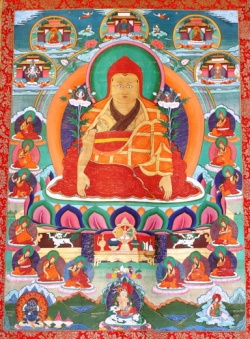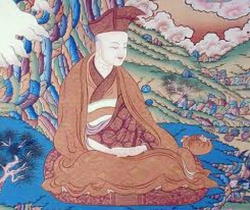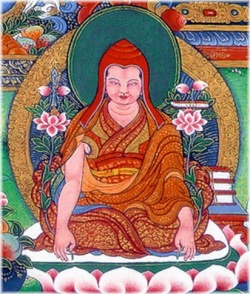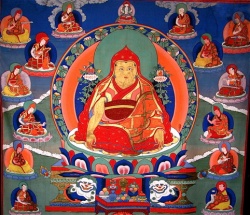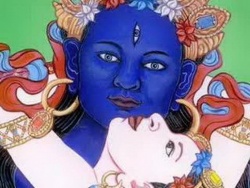The Teachings of the Jonangpa School
by David Reigle
Some seven centuries ago there arose in Tibet a school of teachings which has many parallels to Theosophy. This is the Jonangpa school. Like Theosophy which attempted to restore teachings from "the universally diffused religion of the ancient and prehistoric world" it attempted to restore teachings of the earlier Golden Age. Like Theosophy which teaches as its first fundamental proposition "an omnipresent, eternal, boundless, and immutable principle on which all speculation is impossible, since it transcends the power of human conception," it teaches a principle which is permanent, stable, quiescent, and eternal, which is devoid of anything but itself, or "empty of other" (gzhan stong), and which therefore transcends even the most subtle conceptualization. And like Theosophy, it was persecuted by the orthodoxy.
A Secret Doctrine
The teachings of the Jonangpa school were originated by Yumo Mikyo Dorje (yu mo mi bskyod rdo rje), an eleventh-twelfth century yogi. He was a student of Soma-natha, the Sanskrit pandit and Kalacakra master from Kashmir who translated the great Kalacakra commentary Vimala-prabha into Tibetan. Yumo is said to have received the Jonangpa teachings while practicing the Kalacakra six-limbed yoga in the Mt. Kailasa area of western Tibet. The Jonangpa teachings include primarily the Kalacakra transmission and the "empty of other" or shen-tong (gzhan stong) doctrine. Yumo expounded these as a "secret doctrine" (lkog pa'i chos). He did not, however, put these teachings into writing; so we do not have from him a work called The Secret Doctrine, like we do from H.P. Blavatsky. The task of putting them into writing was left to a successor, Dolpopa.
The Heart Doctrine
These teachings were passed down orally to Dolpopa (also written Dolbupa, 1292-1361) who set into writing the shen-tong or "empty of other" teachings in his most famous book, The Mountain Dharma — The Ocean of Definitive Meaning (ri chos nges don rgya mtsho). These teachings are referred to as the "heart doctrine" (snying po'i don), so Dolpopa describes his book as the "Lamp of the Heart Doctrine."
Regarding the heart doctrine, H.P. Blavatsky states:
To any student of Buddhist Esotericism the term, "the Mystery of the Eye," would show the absence of any Esotericism. Had the word "Heart" stood in its place, then it would have meant what it now only professes to convey. The "Eye Doctrine" means dogma and dead-letter form, church ritualism intended for those who are content with exoteric formulae. The "Heart Doctrine" or the "Heart's Seal" (the Sin Yin), is the only real one.
Golden Age Tradition
Dolpopa wrote another famous book, The Fourth Council (bka' bsdus bzhi pa), which lays out the relationship between the four yugas and the decline of the doctrine. In the Golden Age (krta yuga) the teachings of the Buddhist sacred canon were understood correctly, but this understanding was gradually lost as the third age, the second age, and the dark age progressed. Thus many Buddhist writers of later ages who no longer had the true understanding wrote commentaries which do not explain the teachings correctly. It is Dolpopa's purpose to restore the correct understanding as it was in the Golden Age. Hence he refers to the Jonangpa teachings as the "Golden Age Tradition" (rdzogs ldan lugs).
In the Theosophical article entitled "Tibetan Teachings" H.P. Blavatsky's Tibetan correspondent agrees that the Tibetan Buddhist canon has a dual meaning, and that many Buddhist commentators have not understood the true meaning:
No doubt but that the Chinese and Tibetan Scriptures, so-called, the standard works of China and Japan, some written by our most learned scholars, many of whom — as uninitiated though sincere and pious men — commented upon what they never rightly understood, contain a mass of mythological and legendary matter more fit for nursery folk-lore than an exposition of the Wisdom Religion as preached by the world's Savior. But none of these are to be found in the canon; ... [the canonical texts] contain no fiction, but simply information for future generations, who may, by that time, have obtained the key to the right reading of them.
Note: Dolpopa's books were banned in the 17th century and became extremely rare. In the 1970's and 1980's a few of his books were located and reprinted. In 1990 Matthew Kapstein visited what had been far eastern Tibet, now western China, where some Jonangpa monasteries had survived, and obtained for the U.S. Library of Congress a complete set of Dolpopa's Collected Works. These were reprinted in Delhi in 1992.
The Jonangpa Teachings: Kalacakra and Maitereya
The Jonangpa teachings are based primarily on Kalacakra and the works of Maitreya. I have elsewhere provided evidence linking the "Book of Dzyan" on which The Secret Doctrine is based and the lost mula Kalacakra Tantra. An important passage from a letter of H.P. Blavatsky to A. P. Sinnett also links the Book of Dzyan and the work of Maitreya:
I have finished an enormous Introductory Chapter, or Preamble, Prologue, call it what you will; just to show the reader that the text [of The Secret Doctrine) as it goes, every Section beginning with a page of translation from the Book of Dzyan and the Secret Book of "Maytreya Buddha" Champai chhos Nga (in prose, not the five books in verse known, which are a blind) are not fiction.
Blavatsky here refers to a secret book of Maitreya as opposed to the five books known. It is noteworthy that there came to Tibet from India two schools of interpretation of the Maytreya works: a doctrinal or analytical school whose textual exegesis is still current, and a meditative or practice school thought to have disappeared several centuries ago. According to Leonard van der Kuijp, this school did not die out but rather became the basis of the Jonangpa teachings:
As such, future research may show two things. Firstly, the forerunner of the so-called Jo-nang-pa position and the 'Great madhyamaka' was the meditative, practical school that grew up around these teachings of Maitreya[[[natha]]). In course of time, other texts which expressed similar sentiments, or which were interpreted as maintaining similar ideas, were added to the original corpus of texts on which this tradition based itself. In the second place, it may become possible to show that Dol-po-pa's efforts could be characterized as an attempt to redress the 'Meditative School' according to the normative methodology of the 'Analytical School'.
The specific book of Maitreya on which the fundamental Jonangpa doctrine of shen-tong or "empty of other" is based is the Ratna-gotra-vibhaga, also called the Uttara-tantra. This book contains a synthesis of the tathagata-garbha or "Buddha-matrix" teaching. The tathagata-garbha teaching of a universal matrix or Buddha-nature, which all people have, is so different from other Buddhist teachings that Buddhist writers disagreed on how to classify it. In Tibet, it was classified by some writers as a Madhyamaka teaching, and by others as a Yogacara teaching, though it did not fit well in either category. An early Chinese writer, Fa-tsang (643-712), put it in its own separate category beyond the three accepted ones of Hinayana, Madhyamaka, and Yogacara. Analogously, H.P. Blavatsky speaks of a seventh school of Indian philosophy (darsana) beyond the six accepted ones, the esoteric school:
This is the view of every one of the six great schools of Indian philosophy — the six principles of that unit body of Wisdom of which the 'gnosis,' the hidden knowledge, is the seventh.
The Seven Great Mysteries
The Theosophical Mahatma known under the initials K.H. speaks of seven great mysteries of Buddhist metaphysics:
In connection with this, let me tell you before, that since you seem so interested with the subject you can do nothing better than to study the two doctrines — of Karma and Nirvana — as profoundly as you can. Unless you are thoroughly well acquainted with the two tenets — the double key to the metaphysics of Abhidharma — you will always find yourself at sea in trying to comprehend the rest. We have several sorts of Karma and Nirvana in their various applications — to the Universe, the world, Devas, Buddhas, Bodhisattvas, men and animals — the second including its seven kingdoms. Karma and Nirvana are but two of the seven great mysteries of Buddhist metaphysics; and but four of the seven are known to the best orientalists, and that very imperfectly.
Maitreya's Ratna-gotra-vibhaga, source book of the tathagata-garbha or "Buddha-matrix" teaching, opens by listing seven vajra-subjects. Vajra means diamond; and the analogy is given in the commentary by Aryasanga that like a diamond is hard to penetrate, so these subjects are hard to understand. Thus they may be called mysteries. Here is this opening verse:
1. Buddha, doctrine (dharma), community (gana = sangha), element (dhatu), enlightenment (bodhi = nirvana), virtuous qualities (guna), and lastly buddha-action (karma); these seven diamond-like subjects (vajra-pada), are in brief, the body of the whole text.
[notes: Dhatu is perhaps the key term in the Ratna-gotra-vibhanga. Its basic meaning is "Element" (Hookham), also "the Germ (of Buddhahood)" (Obermiller), "the Essence [of the Buddha)" (Takasaki), "buddha-nature" (Holmes). The seven vajra-padas each have a conventional (samvrti) and an ultimate (paramartha) aspect. Dhatu when obscured is called tathagata-garbha; when unobscured it is called dharma-kaya. ] This text gives these seven vajra-subjects from the standpoint of non-dual wisdom (jnana). In other words, it gives them in a form which is not very accessible to the mind. Thus readers should not expect to find the seven great mysteries spelled out clearly for them in this text. For as H.P. Blavatsky says regarding one of the stanzas she translated from the "Book of Dzyan:"
Its language is comprehensible only to him who is thoroughly versed in Eastern allegory and its purposely obscure phraseology.
However, some of these seven subjects, such as karma, are given in a form which is more accessible to the mind (i.e., from the standpoint of prajna) in a work which forms part of the standard monastic curriculum, the Abhidharma-kosa by Vasubandhu.
The One Element
The key term in Maitreya's Ratna-gotra-vihhaga is dhatu, or element. It is described in the following important verse:
80. It is not born, does not die, is not afflicted, and does not grow old, because it is permanent (nitya/rtag-pa), stable (dhruva/brtan-pa), quiescent (siva/zhi-ba), and eternal (sasvata/g.yung-drung). — Ratna-gotra-vibhaga or Uttara-tantra, by Maitreya, verse 80
As noted earlier, this one thing, dhatu or element, may be called tathagata-garbha or Buddha-nature when obscured, and dharma-kaya or body of the law when unobscured.
The one element is also a key concept in the Theosophical teachings as found in the Mahatma letters:
However, you will have to bear in mind (a) that we recognize but one element in Nature (whether spiritual or physical) outside which there can be no Nature since it is Nature itself, and which as the Akasa pervades our solar system, every atom being part of itself, pervades throughout space and is space in fact, ... (b) that consequently spirit and matter are one, being but a differentiation of states not essences, ... (c) that our notions of "cosmic matter" are diametrically opposed to those of western science.
Perchance if you remember all this we will succeed in imparting to you at least the elementary axioms of our esoteric philosophy more correctly than heretofore.
Yes, as described in my letter — there is but one element and it is impossible to comprehend our system before a correct conception tion of it is firmly fixed in one's mind. You must therefore pardon me if I dwell on the subject longer than really seems necessary. But unless this great primary fact is firmly grasped the rest will appear unintelligible. This element then is the — to speak metaphysically — one sub-stratum or permanent cause of all manifestations in the phenomenal universe.
We will say that it is, and will remain for ever demonstrated that since motion is all-pervading and absolute rest inconceivable, that under whatever form or mask motion may appear, whether as light, heat, magnetism, chemical affinity or electricity — all these must be but phases of One and the same universal omnipotent Force, a Proteus they bow to as the Great "Unknown" (See Herbert Spencer) and we, simply call the "One Life," the "One Law" and the "One Element."
These last three epithets, the "One Life," the "One Law," and the "One Element," correspond well to the Ratna-gotra-vibhaga's terms tathagata-garbha, dharma-kaya, and dhatu, respectively.
Tsong-kha-pa's Critique of the Jonangpa Teachings
The Jonangpa teaching of a permanent, stable, quiescent, and eternal dhatu or tathagata-garbha or dharma-kaya which is "empty of other" (gzhan stong) and therefore ultimately beyond the range and reach of thought, was apparently criticized by Tsong-kha-pa, founder of the Gelugpa or "Yellow Hat" order. One of Tsong-kha-pa's most famous books is the Legs bshad snying po, or "Essence of True Eloquence," which he wrote after emerging from his highest enlightenment experience, so it is thought to give his final insights. While it never mentions names, the object of much of its critique is identified by Gelugpa exegesis as Dolpopa and the Jonangpa teachings. Tsong-kha-pa, 1357-1419, lived just after Dolpopa, 1292-1361. This critique is of much importance to Theosophists, since Dolpopa apparently teaches the first fundamental proposition of The Secret Doctrine, and Tsong-kha-pa apparently refutes it; yet Tsong-kha-pa is regarded by Theosophists as "the reformer of esoteric as well as of vulgar Lamaism," and as "the founder of the Gelukpa ("yellow-cap") Sect, and of the mystic Brotherhood connected with its cheifs," "the founder of the secret School near Shigatse, attached to the private retreat of the Teshu-Lama."
In regard to this question, we may compare a Brahmin Theosophist's comments on a somewhat analogous situation with Gautama Buddha and Sankaracarya, remembering that Theosophical sources place Buddha's death in 543 B.C. and Sankaracarya's birth shortly after in 510 B.C.:
The movement of Lord Buddha must have produced an enormous confusion in this land as you may all imagine and the great philosopher who took upon himself the task of restoring order is Sankaracharya. He preserved the essence of what Lord Buddha had said and spoke as was suitable to the people of the time. For example he substituted the Vedantic Parabrahman for the Buddhistic No-thing [[[emptiness]], sunyata) ... The object of our great reformer was not to teach any esoteric science but to restore order in a country which could not bear up the boldness to catch the truth that Lord Buddha taught and consequently fell into confusion. He therefore did not take up things in any puranic fashion to trace the operation of tile cosmic law which has brought about this wonderful variation in manifestation from the one nonmanifestation. That the world is an illusion and Parabrahman is alone real is a good cover under which shelter could be taken under circumstances which require a revelation of esoteric truth for clearing up ... Note here my friends, how the great philosopher has evaded the business of giving out esoteric truths which alone serves as a unifying power at reconciling the apparent contradictions in ancient writings.
The Teacher wanted only to impress upon the minds of the students that the universe is one in its essence and apparently many in its manifestation. That has had its own share of evil effect on the minds of the students at least as they are found now. The vast majority of Vedantic students learn by their study only the quibble "Parabrahman truth, everything illusion." I shall not now go into a declamatory flourish of language against our poor Vedantists but I shall say a few things for your benefit and guidance in the study of the Bhagavad Gita from the standpoint of the ancient yajnikas. To these philosophers, Nature is not an illusion but the eternal ground of evolution, of an infinite one existence which permeating every point in the infinity of space or taking the place of the heart in all, tries to obtain a more and more vivid consciousness by its own ideal life processes. This heart of the universe, existing everywhere in it, is called by them the eternal yajna-purusha or the purusha who underlies all cosmic manifestations.
Tsong-kha-pa in his highest enlightenment experience would have achieved full insight into the operation of the twelvefold chain of causation, and would have seen the future effects of whatever teachings he might give. For the Buddhist enlightenment is, as described by H.P. Blavatsky:
... the attainment of that supreme perfection which leads the Initiate to remember the whole series of his past lives, and to foresee that of the future ones, by the full development of that inner, divine eye in him, and to acquire the knowledge that unfolds the causes (the twelve Nidanas called in Tibetan Ten-brel Chu-gnyi, which are based upon the "Four Truths") of the ever-recurring cycles of existence ...
Thus Tsong-kha-pa may well have chosen to give public teachings which his insight showed him would be most effective in meeting the spiritual needs of his future audiences, while at the same time keeping his esoteric teachings from public view. His public teachings did indeed radically transform Tibetan Buddhism, being aptly compared to the Copernican Revolution wherein Europeans discovered that the earth revolves around the sun rather than vice versa. His His on esoteric teachings was reported by H.P. Blavatsky's Tibetan correspondent:
Our world-honored Tsong-kha-pa closing his fifth Dam-ngag reminds us that 'every sacred truth, which the ignorant are unable to comprehend under its true light, ought to be hidden within a triple casket concealing itself as the tortoise conceals his head within his shell; ought to show her face but to those who are desirous of obtaining the condition of Anuttara Samyak Sambodhi' — the most merciful and enlightened heart.
We have another somewhat analogous situation in our own time with Helena P. Blavatsky, 1831-1891, primary founder of the Theosophical Society, and Jiddu Krishnamurti, 1895-1986, who left the Theosophical Society in 1929 and spent the rest of his life teaching that people should not rely on authority. For Theosophists, he did not deny the Theosophical teachings, but only repudiated the role of the Theosophical Society and the beliefs accepted by Theosophists on authority as leading to truth. He taught that one cannot come to truth through any organization or belief. For most followers of Krishnamurti's teachings today, however, he also refuted the Theosophical teachings, such as that of an omnipresent, eternal, boundless and immutable principle which transcends the power of human conception; just as for his own Gelugpas, Tsong-kha-pa refuted the Jonangpa teaching of a permanent, stable, quiescent and eternal dhatu or tathagata-garbha or dharma-kaya which is devoid of anything but itself (gzhan stong) and so transcends even the most subtle conceptualization.
Notes
1. The Secret Doctrine, by H.P. Blavatsky, 1888; reprint, Adyar, Madras: Theosophical Publishing House, 1978, vol. I, p. xxxiv.
2. The Secret Doctrine, vol. I, p. 14.
3. See: "The Jo nan pas: A School of Buddhist Ontologists According to the Grub mtha' sel gyi me lon," by D. S. Ruegg, Journal of the American Oriental Society, vol. 83, 1963, p. 83.
4. See: The Buddha Within: Tathagatagarbha Doctrine According to the Shentong Interpretation of the Ratnagotravibhaga, by S. K Hookham, Albany: State University of New York Press, 1991, p. 142.
5. The Secret Doctrine, Adyar 6-vol. edition, vol. 5, p. 407; or, H.P. Blavatsky Collected Writings, vol. XIV, Wheaton, Illinois: Theosophical Publishing House, 1985, pp. 444-45.
6. See: The 'Dzam-thang Edition of the Collected Works of Kun-mkhyen Dol-po-pa Shes-rab Rgyal-mtshan: Introduction and Catalogue, by Matthew Kapstein, Delhi: Shedrup Books, 1992, p. 51.
7. H.P. Blavatsky Collected Writings, vol. VI, 1954; 2nd ed., Wheaton, Illinois: Theosophical Publishing House, 1975, p. 100.
8. See my: "New Light on the Book of Dzyan," in Symposium on H.P. Blavatsky's Secret Doctrine ... Proceedings, San Diego: Wizards Bookshelf, 1984, pp. 54-67.
9. The Letters of H.P. Blavatsky to A. P. Sinnett, 1925; reprint, Pasadena: Theosophical University Press, 1973, p. 195.
10. Contributions to the Development of Tibetan Buddhist Epistemology, by Leonard W.J. van der Kuijp, Wiesbaden: Franz Steiner Verlag, 1983, p. 44.
11. See: The Awakening of Faith, trans. Yoshito S. Hakeda, New York and London: Columbia University Press, 1967, p. 14: "In the introduction to his commentary to the Awakening of Faith, Fa-tsang made an attempt to classify all Indian Buddhism under the following four categories: (1) Hinayana; (2) Madhyamika; (3) Yogacara; and (4) Tathagatagarbha."
12. The Secret Doctrine, vol. I, p. 278.
13. The Mahatma Letters to A.P. Sinnett, compiled by A.T. Barker, 1923; third and revised edition, Adyar, Madras: Theosophical Publishing House, 1962, p. 107.
14. See: "The Sublime Science of the Great Vehicle to Salvation," by E. Obermiller, Acta Orientalia, vol. IX, 1931; reprinted as Uttaratantra or Ratnagotravibhaga, Talent, Oregon: Canon Publications, 1984, p. 111.
15. See: The Buddha Within: Tathagatagartha Doctrine According to the Shentong lnterpretation of the Ratnagotravibhaga, by S. K. Hookham, p. 93.
16. The Secret Doctrine, vol. I, p. 106.
17. English translation by Leo M. Pruden as Abhidharmakosabhasyam, from the French translation by Louis de La Vallee Poussin, 4 vols., Berkeley: Asian Humanities Press, 1988, 1988, 1989, 1990. Includes commentary ( bhasyam). Karma is the subject of chapter 4.
18. The Mahatma Letters to A. P. Sinnett, 3rd ed., p. 63.
19. The Mahatma Letters to A. P. Sinnett, 3rd ed., p. 89.
20. The Mahatma Letters to A. P. Sinnett, 3rd ed., pp. 155-56.
21. English translation by Robert A. F. Thurman as Tsong Khapa's Speech of Gold in the Essence of True Eloquence: Reason and Enlightenment in the Central Philosophy of Tibet, Princeton: Princeton University Press, 1984.
22. The Mahatma Letters to A. P. Sinnett, 3rd ed., p. 44.
23. The Theosophical Glossary, by H.P. Blavatsky, 1892; reprint, Los Angeles: The Theosophy Company, 1971, p. 305.
24. H.P. Blavatsky Collected Writings, vol. XIV, p. 425.
25. For the dates, see: Five Years of Theosophy, [edited by George Robert Stow Mead,] 1885; second and revised edition, London: Theosophical Publishing Society, 1894, pp. 195, 236. The quotation is from Thoughts on Bagavad Gita, by A Brahmin F.T.S., 1893; reprinted as Some Thoughts on the Gita, Talent, Oregon: Eastern School Press, 1983, pp. 100-103.
26. The Secret Doctrine, Adyar 6-vol. edition, vol. 5, p. 397; or, H.P. Blavatsky Collected Writings, vol. XIV, p. 432.
27. See: Contributions to the Development of Tibetan Buddhist Epistemology, by Leonard W.J. van der Kuijp, p. 45: "I do not think it an exaggeration to suggest that what Tsong-kha-pa succeeded in doing constituted nothing less than a 'Copernican Revolution' for Tibetan Buddhism, and the significance of his reinterpretation of Indian Buddhism cannot be stressed enough, particularly with respect to the later developments of Tibetan Buddhism."
28. In: "Tibetan Teachings," H.P. Blavatsky Collected Writings, vol. VI, pp. 99-100.
29. See: Krishnamutti: His Life and Death, by Mary Lutyens, New York: St. Martin's Press, 1990, p. 149: "Truth is a pathless Land. Man cannot come to it through any organization,, through any creed, through any dogma, priest or ritual, not through any philosophical knowledge or psychological technique."

